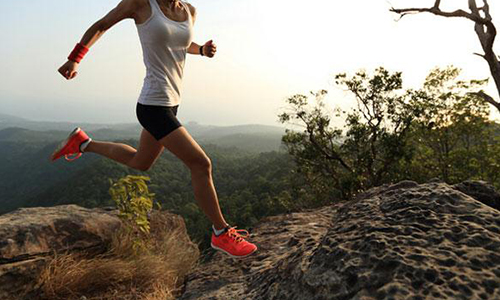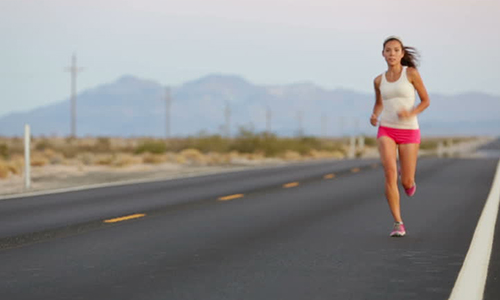Here’s how you can choose the right pair of fitness shoes
Author

Chris shares his passion for cycling, hiking, skiing, and climbing from Buxton, in the Peak District. As a blogger for Outdoor Look, Chris shares outdoor tips and indoor tricks to help you get the most out of your time spent outside. When he's not out adventuring he's making videos or trying to keep up with his 4-year-old son.
 Choosing the right pair of shoes is the first and the foremost step in your bid to be fit. It doesn’t really matter whether you plan to hit the trails for a backcountry run, or hop on the treadmill for some light training, the footwear you choose can make a world of difference. Let us go through the basics of how to choose the ideal running and training shoes for you to begin your next fitness goal.
Choosing the right pair of shoes is the first and the foremost step in your bid to be fit. It doesn’t really matter whether you plan to hit the trails for a backcountry run, or hop on the treadmill for some light training, the footwear you choose can make a world of difference. Let us go through the basics of how to choose the ideal running and training shoes for you to begin your next fitness goal.
When it comes to training shoes, there are the three major categories:
- Cross-training shoes
- Road-running shoes
- Trail-running shoes
You have a lot of options to choose from within these three broad categories
Cross-training Shoes
These type of shoes are ideal while undertaking an array of athletic activities. You can wear these if you undertake weight lifting and cardio-related workouts. These shoes can also be worn while covering short distances.
About These Shoes: A good pair of cross-training shoes is lightweight and features a wide outsole to supplement stability and lateral movement. It is something that is rarely taken into consideration while designing running shoes. Also, cross trainers come with very low heel-to-toe drop in order to enhance stability. These type of shoes come with a good amount of responsive cushion in the midsole.
Why Choose Cross-training Shoes? Cross trainers are an ideal option for those who have a varied fitness routine. Weight lifters and power lifters can go for cross-training shoes.
Road-Running Shoes
 Road-running shoes are tailor-made for running long distances on roads and smooth surfaces. These shoes are lightweight and support your feet while traditional running is being undertaken.
Road-running shoes are tailor-made for running long distances on roads and smooth surfaces. These shoes are lightweight and support your feet while traditional running is being undertaken.
About the Road-Running Shoes: Here, you need to look for a cushioning system that supports your forefoot. The specific arch and type of your foot is something that will decide what features you want in your road-running shoe.
Why choose Road-Running shoes? These can be used for running on either pavements or treadmills. Also, these shoes can be used on both indoor as well as outdoor tracks.
Trail-Running Shoes
These are ideal while undertaking a run on rugged, non-paved ground. Trail-running shoes can be for running outside in wet, mucky conditions because many of them come with full waterproof features. These types of shoes are heavier than road-running shoes, and feature a lugged outsole to grip varied grounds, so they aren't the best choice for running long distances on paved surfaces or treadmills. Some hikers choose trail-running shoes over classic hiking boots for lighter, more mobile footwear.
Why Choose Trail-Running Shoes: A lugged outsole is the striking feature to look for in a trail-running shoe. The outsole will be thick with deep indentations for improved traction and stability. The upper is designed with overlays to prevent rocks and other trail debris from entering the shoe. If you are the type to go on runs through rocky trails, look for a rubber toe guard for that added bit of extra protection, you don't want to be stubbing your toe on a rock in the middle of a run.
Why Trail-Running Shoes: People who want to keep fit whilst still getting to enjoy the beauty of the nature rather than the four walls of a gym will love the trail-running option. Wear trail-running shoes for all types of trails, dirt paths and any countryside running that requires more grip.
Author

Chris shares his passion for cycling, hiking, skiing, and climbing from Buxton, in the Peak District. As a blogger for Outdoor Look, Chris shares outdoor tips and indoor tricks to help you get the most out of your time spent outside. When he's not out adventuring he's making videos or trying to keep up with his 4-year-old son.
- Speed Up Your Post-Hike Recovery with These 6 Essential Tips
- Cycling through Tranquil Roads and Coastal Views on the Isle of Wight
- The Essential Guide to Hiking Safety: 5 Tips Every Hiker Should Know
- Run Smart, Run Strong: Your Guide to Injury-Free Running
- Embrace Biking: Essential Tips for Beginners
Categories
- Sport (28)
- Product Reviews (3)
- Team Outdoor Look (7)
- Mike Wild (2)
- Mike Payton (2)
- Suse Hammond-Pears (3)
- Snowboarding (12)
- Latest Offers (105)
- Shop Talk (1)
- Competitions (7)
- Walking (413)
- Lifestyle Fashion (8)
- Travel (86)
- Kit Guides (176)
- Workwear Clothing (6)
- Safety Workwear (4)
- Health/Fitness (289)
- Skiing (91)
- Great Outdoors (1316)
- Cycling (92)
- January 2025
- December 2024
- November 2024
- October 2024
- September 2024
- August 2024
- July 2024
- June 2024
- May 2024
- April 2024
- March 2024
- February 2024
- January 2024
- December 2023
- November 2023
- October 2023
- September 2023
- August 2023
- July 2023
- June 2023
- May 2023
- April 2023
- March 2023
- February 2023
- January 2023
- December 2022
- November 2022
- October 2022
- September 2022
- August 2022
- July 2022
- June 2022
- May 2022
- April 2022
- March 2022
- February 2022
- January 2022
- December 2021
- November 2021
- October 2021
- September 2021
- August 2021
- July 2021
- June 2021
- May 2021
- April 2021
- March 2021
- February 2021
- January 2021
- December 2020
- November 2020
- October 2020
- September 2020
- August 2020
- July 2020
- June 2020
- May 2020
- April 2020
- March 2020
- February 2020
- January 2020
- December 2019
- November 2019
- October 2019
- September 2019
- August 2019
- July 2019
- June 2019
- May 2019
- April 2019
- March 2019
- February 2019
- January 2019
- December 2018
- November 2018
- October 2018
- September 2018
- August 2018
- July 2018
- June 2018
- May 2018
- April 2018
- March 2018
- February 2018
- January 2018
- December 2017
- November 2017
- October 2017
- September 2017
- August 2017
- July 2017
- June 2017
- May 2017
- April 2017
- March 2017
- February 2017
- January 2017
- December 2016
- November 2016
- October 2016
- September 2016
- August 2016
- July 2016
- June 2016
- May 2016
- April 2016
- March 2016
- February 2016
- January 2016
- December 2015
- November 2015
- October 2015
- September 2015
- August 2015
- July 2015
- June 2015
- May 2015
- April 2015
- March 2015
- February 2015
- January 2015
- December 2014
- November 2014
- October 2014
- September 2014
- August 2014
- July 2014
- June 2014
- May 2014
- April 2014
- March 2014
- February 2014
- January 2014
- December 2013
- November 2013
- October 2013
- September 2013
- August 2013
- July 2013
- June 2013
- May 2013
- April 2013
- March 2013
- February 2013
- January 2013
- December 2012
- November 2012
- October 2012
- September 2012
- August 2012
- July 2012
- June 2012
- May 2012
- April 2012
- March 2012
- February 2012
- January 2012
- December 2011
- November 2011
- October 2011
- September 2011
- August 2011
- May 2010
- April 2010
- March 2010
- February 2010
- January 2010
- November 2009
- October 2009
- September 2009
Submit a Comment